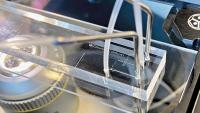Columbia Develops STAR Technology for Men With Infertility

By Helen Gary
The Columbia University Fertility Center is using advanced imaging, artificial intelligence, robotics, and microfluidics to recover rare sperm cells in men with no detectable sperm in their ejaculate.
The condition, called azoospermia, affects approximately 10%-15% of men with infertility. It may be caused by structural abnormalities in the testes, prior surgical procedures, or previous treatment with radiation therapy or chemotherapy.
“With our method, many men who were previously told they have no chance of having a biological child now have that chance,” says Zev Williams, MD, PhD, the Wendy D. Havens Associate Professor of Women’s Health and director of the center at VP&S.
The STAR (Sperm Tracking and Recovery) method was inspired by high-tech tools that astrophysicists use to find celestial bodies in a universe filled with stars, planets, and other matter.
A Need for Alternatives
Healthy semen contains up to hundreds of millions of sperm cells per milliliter. Men with azoospermia have virtually no sperm in their semen.
“A semen sample can appear totally normal, but when you look under the microscope, you discover just a sea of cellular debris, with no sperm visible,” Dr. Williams says.
Men with azoospermia who wish to have a biological child have very few options outside of adoption or sperm donation.
Some men with the condition may have a surgical procedure to extract sperm from the testes. However, this painful procedure is not always successful and can cause complications, including vascular problems, inflammation, and a temporary decrease in testosterone levels.
Another option is to process the semen sample with a centrifuge and then have specially trained technicians manually inspect the sample to find sperm. However, only a handful of laboratories perform this lengthy and costly method, which can damage the sperm and make it unusable.
A STAR is Born
STAR was developed by a team of research scientists and clinicians at the fertility center, with Hemant Suryawanshi, PhD, serving as team lead in collaboration with experts in microfabrication, machine learning, and robotics.
First, the team employed high-powered imaging technology to scan an entire sample, taking over 8 million images in under an hour. A machine learning algorithm was developed to identify the individual sperm cells amidst a sea of debris.
Next, the team worked with microfluidics experts at Columbia to produce a chip engraved with a series of channels as thin as a human hair to isolate the portion of the sample containing the sperm cell.
Then, a robot was programmed to gently remove individual sperm cells milliseconds after they are discovered, bypassing the need for a centrifuge, lasers, dyes, or other damaging treatments.
Once a sperm cell is recovered, it can be inserted directly into an egg to create an embryo or frozen for future use.
“The challenge is like trying to find a needle hidden among a thousand haystacks—but doing it within one hour, and so gently that the sperm can be used to fertilize an egg and ultimately result in a successful pregnancy and healthy baby,” says Dr. Williams.
Since STAR was unveiled last year, it has helped dozens of patients at the Fertility Center. One couple, who had been trying to conceive for 19 years, finally got their wish and started a pregnancy with sperm retrieved by STAR.
“We’re using the same technologies that are used to search for life in the universe to help create new life right here on Earth,” says Dr. Williams. “It’s truly awe-inspiring to be able to help patients build the family they always dreamed of.”
Learn more about the Columbia University Fertility Center at columbiadoctors.org/fertility-center or 646-756-8282.